Walking Tour
The City of Fort Myers has a public art collection that rivals those found in larger Florida cities such as Miami, Orlando, Sarasota, Tampa, St. Petersburg and West Palm Beach. But unlike those destinations, the vast majority of Fort Myers’ impressive and extensive public artworks are within mere blocks of each other. Here are instructions for taking a walking tour of the major public artworks that are located in the downtown Fort Myers River District.
For this tour, you will want:
- comfortable walking shoes;
- a coolie and a bottled water to keep hydrated (if you are taking the tour during the day);
- your camera; and
- an iPad or smart phone so that you can access www.swfl.com.
Depending on your pace and how much time you prefer to spend admiring each artwork, the tour will take you about two hours to complete.
The tour starts in Centennial Park, so park in the lot to the west of the intersection of Heitman and Bay avenues in downtown Fort Myers. It’s a public lot, so parking is free.
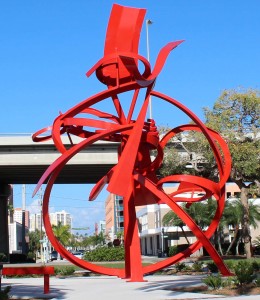 First Stop: Fire Dance by David Black. Located in a concrete circle where Bay Street dead-ends at the eastern edge of Centennial Park, you will discover a 25-foot-tall Dupont red aluminum sculpture that rivals the palm trees that circumscribe it. The name of the sculpture is Fire Dance, and it is the first commission awarded to an artist by the City of Fort Myers Public Art Committee.
First Stop: Fire Dance by David Black. Located in a concrete circle where Bay Street dead-ends at the eastern edge of Centennial Park, you will discover a 25-foot-tall Dupont red aluminum sculpture that rivals the palm trees that circumscribe it. The name of the sculpture is Fire Dance, and it is the first commission awarded to an artist by the City of Fort Myers Public Art Committee.
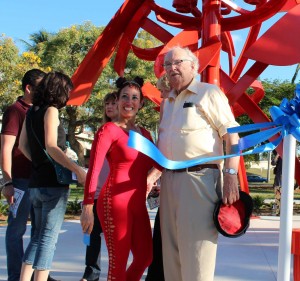 The sculptor is David Black and the Public Art Committee chose him out of a field of 162 artists who responded to the City’s RFQ, a national call to artists interested in submitting their qualifications and proposals. Fire Dance represents the 38th time Black has won a public art competition. He has 34 other sculptures in cities throughout the United States and three more abroad – one in Nagano, Japan, a second in Berlin and the third in Canada.
The sculptor is David Black and the Public Art Committee chose him out of a field of 162 artists who responded to the City’s RFQ, a national call to artists interested in submitting their qualifications and proposals. Fire Dance represents the 38th time Black has won a public art competition. He has 34 other sculptures in cities throughout the United States and three more abroad – one in Nagano, Japan, a second in Berlin and the third in Canada.
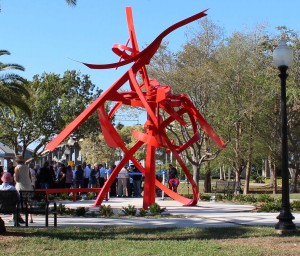 Black characterizes himself as a “hands-on” sculptor-innovator with a wide interest in architecture, past and present. He calls his public sculpture “proto-architecture” because it combines architectural elements such as pillars, arches, canopies and the use of light with the energy and references of sculpture. His community landmarks engage their environments spatially as well as culturally, connecting strongly with the viewer. “When designing a sculpture,” Black observes, “you have to consider the site. Here, I wanted my piece to be taller than the surrounding palm trees. You must consider the elements as well. Because of southwest Florida’s intense sunlight, I’ve had Dupont add UV protection, like sunscreen, to the paint to retard fading.”
Black characterizes himself as a “hands-on” sculptor-innovator with a wide interest in architecture, past and present. He calls his public sculpture “proto-architecture” because it combines architectural elements such as pillars, arches, canopies and the use of light with the energy and references of sculpture. His community landmarks engage their environments spatially as well as culturally, connecting strongly with the viewer. “When designing a sculpture,” Black observes, “you have to consider the site. Here, I wanted my piece to be taller than the surrounding palm trees. You must consider the elements as well. Because of southwest Florida’s intense sunlight, I’ve had Dupont add UV protection, like sunscreen, to the paint to retard fading.”
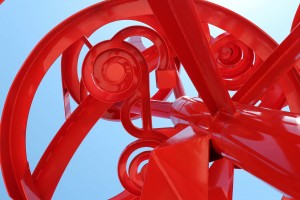 The sculpture is open so that people can walk through it and look up. “Inside the piece are four hidden spirals that create a story for your imagination,” Black told the crowd who gathered for the sculpture’s March 2, 2012 dedication and ribbon cutting ceremony. “I like the idea of letting people walk around the sculpture and see it from underneath,” Black says. “I want them to enjoy the piece from every angle.” Toward that end, Fire Dance has been encircled by a sidewalk and landscaping, and is framed by park benches so that visitors to Centennial Park can freely interact with the sculpture from every conceivable vantage.
The sculpture is open so that people can walk through it and look up. “Inside the piece are four hidden spirals that create a story for your imagination,” Black told the crowd who gathered for the sculpture’s March 2, 2012 dedication and ribbon cutting ceremony. “I like the idea of letting people walk around the sculpture and see it from underneath,” Black says. “I want them to enjoy the piece from every angle.” Toward that end, Fire Dance has been encircled by a sidewalk and landscaping, and is framed by park benches so that visitors to Centennial Park can freely interact with the sculpture from every conceivable vantage.
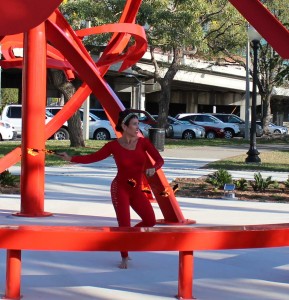 Fire Dance represents Black’s interpretation of the park’s energy and vitality during events. “My wife, Karlita, and I first visited Centennial Park at night. We walked right into a jazz festival. Fire Dance incorporates the sounds of the music and the noise of the crowd. Circles within circles; it’s active, open, airy and rhythmic, just like jazz. And being originally from Gloucester [Massachusetts], I had to include some blades and sails in the design,” Black explains, making reference to the sculpture’s location close to the banks of the Caloosahatchee River.
Fire Dance represents Black’s interpretation of the park’s energy and vitality during events. “My wife, Karlita, and I first visited Centennial Park at night. We walked right into a jazz festival. Fire Dance incorporates the sounds of the music and the noise of the crowd. Circles within circles; it’s active, open, airy and rhythmic, just like jazz. And being originally from Gloucester [Massachusetts], I had to include some blades and sails in the design,” Black explains, making reference to the sculpture’s location close to the banks of the Caloosahatchee River.
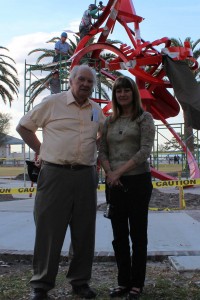 “Imagination is always the fire; improv the heart,” says the sculptor of his creation (pictured left with Public Art Committee chair Ava Roeder). “It is my hope that Fire Dance will lift each viewer’s spirits and deepen their sense of community with Fort Myers by engendering a sense of civic pride.”
“Imagination is always the fire; improv the heart,” says the sculptor of his creation (pictured left with Public Art Committee chair Ava Roeder). “It is my hope that Fire Dance will lift each viewer’s spirits and deepen their sense of community with Fort Myers by engendering a sense of civic pride.”
[If you’d like to know more about David Black, how he got started in making monumental public artworks, and some of the modernist sculptures he has installed in other locales, please visit http://www.artswfl.com/galleries/fort-myers-river-district/public-art-installations/fire-dance/fire-dance.]
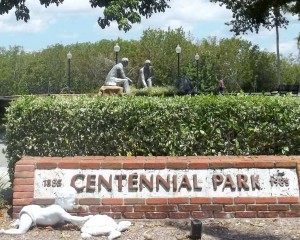 Second Stop: The Great Turtle Chase. Now head east to Heitman Street, turn left (north) and walk to Edwards Drive. There, turn right (east) and follow the walkway to the entrance of Centennial Park, Fort Myers’ beautiful ten-acre community park located on the scenic banks of the Caloosahatchee River. You can’t miss the entrance. It is demarcated by a red brick bordered sign. At the sign’s base is a white marble sculpture called The Great Turtle Chase. Dedicated in 1990, it was cast by D.J. Wilkins, who former mayor Art Hammel once proclaimed as “the official sculptor of Fort Myers” because of the numerous (23) representational sculpture he has created for the city over the years.
Second Stop: The Great Turtle Chase. Now head east to Heitman Street, turn left (north) and walk to Edwards Drive. There, turn right (east) and follow the walkway to the entrance of Centennial Park, Fort Myers’ beautiful ten-acre community park located on the scenic banks of the Caloosahatchee River. You can’t miss the entrance. It is demarcated by a red brick bordered sign. At the sign’s base is a white marble sculpture called The Great Turtle Chase. Dedicated in 1990, it was cast by D.J. Wilkins, who former mayor Art Hammel once proclaimed as “the official sculptor of Fort Myers” because of the numerous (23) representational sculpture he has created for the city over the years.
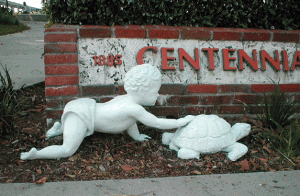 “When we built the Centennial Park sign,” Wilkins reports, “I was looking for a symbol to represent the change of centuries and settled on this. The baby symbolizes the new century coming in and the turtle represents the old, outgoing century.”
“When we built the Centennial Park sign,” Wilkins reports, “I was looking for a symbol to represent the change of centuries and settled on this. The baby symbolizes the new century coming in and the turtle represents the old, outgoing century.”
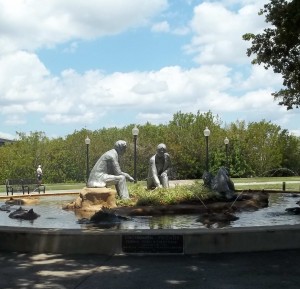 Third Stop: Uncommon Friends. D.J. Wilkins was also responsible for our next stop, Uncommon Friends. Part sculpture, part fountain and part reflection pool, Uncommon Friends is a homage to Fort Myers’ most famous winter residents, Thomas Alva Edison (pictured laying on his side), Henry Ford (seated on a rock) and Harvey Firestone (kneeling in front of a campfire).
Third Stop: Uncommon Friends. D.J. Wilkins was also responsible for our next stop, Uncommon Friends. Part sculpture, part fountain and part reflection pool, Uncommon Friends is a homage to Fort Myers’ most famous winter residents, Thomas Alva Edison (pictured laying on his side), Henry Ford (seated on a rock) and Harvey Firestone (kneeling in front of a campfire).
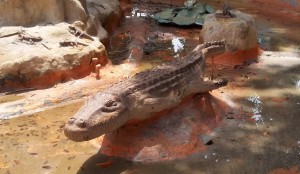 In the water surrounding the island that Edison, Ford and Firestone occupy are life-size sculptures of a mother alligator and her five babies, a mother manatee and her calf, 16 fish, four floating lily pad groups that are piped as fountain heads, and 12 frogs sitting on 6 small protrusions of land that similarly double as fountain heads. Wilkins not only cast all the sculptures, he engineered, wired, piped and constructed the fountain and pool.
In the water surrounding the island that Edison, Ford and Firestone occupy are life-size sculptures of a mother alligator and her five babies, a mother manatee and her calf, 16 fish, four floating lily pad groups that are piped as fountain heads, and 12 frogs sitting on 6 small protrusions of land that similarly double as fountain heads. Wilkins not only cast all the sculptures, he engineered, wired, piped and constructed the fountain and pool.
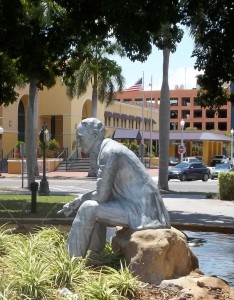 Mayor Hammel requested that Wilkins “make something for our new Centennial Park.” After accepting the commission, Wilkins spent a year researching the relationship shared by Edison, Ford and Firestone. Among the people with whom Wilkins consulted was James D. Newton, a close friend of the three inventors and author of a book about them by the name of Uncommon Friends. “He was a friend of mine,” Wilkins told journalist Andrea Galabinski in July of 2009, “so I called him up and asked, ’What do you think about my naming the statue I’m doing for Centennial Park ‘Uncommon Friends,’ the same as your book?’ He said he’d be honored, but I said, ’You’d be honoring me,’ so that’s how it got its name.”
Mayor Hammel requested that Wilkins “make something for our new Centennial Park.” After accepting the commission, Wilkins spent a year researching the relationship shared by Edison, Ford and Firestone. Among the people with whom Wilkins consulted was James D. Newton, a close friend of the three inventors and author of a book about them by the name of Uncommon Friends. “He was a friend of mine,” Wilkins told journalist Andrea Galabinski in July of 2009, “so I called him up and asked, ’What do you think about my naming the statue I’m doing for Centennial Park ‘Uncommon Friends,’ the same as your book?’ He said he’d be honored, but I said, ’You’d be honoring me,’ so that’s how it got its name.”
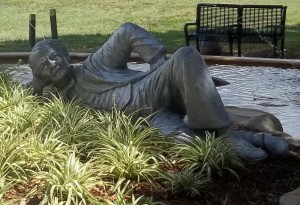 Today, three men out camping would probably be dressed in T-shirts, shorts and boat shoes or flip flops, but Wilkins attired Ford, Firestone and Edison in three-piece suits, ties and dress shoes undoubtedly because that’s how men dressed in the 1920s, even while camping out in the heat and humidity that typifies this region of the south.
Today, three men out camping would probably be dressed in T-shirts, shorts and boat shoes or flip flops, but Wilkins attired Ford, Firestone and Edison in three-piece suits, ties and dress shoes undoubtedly because that’s how men dressed in the 1920s, even while camping out in the heat and humidity that typifies this region of the south.
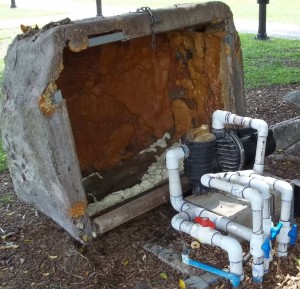 The pump housing for the fountain is a plaster boulder to the east side of the wide circular sidewalk and park benches that surround the fountain and sculptures, allowing park visitors to view the installation with a full panorama of backdrops including the Harborside Event Center, the marina, and the bridge over the Caloosahatchee River.
The pump housing for the fountain is a plaster boulder to the east side of the wide circular sidewalk and park benches that surround the fountain and sculptures, allowing park visitors to view the installation with a full panorama of backdrops including the Harborside Event Center, the marina, and the bridge over the Caloosahatchee River.
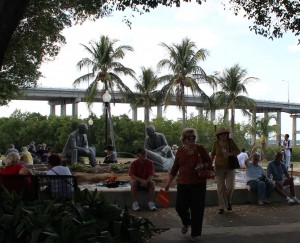 The sculpture and fountain are not about Edison’s, Ford’s and Firestone’s inventions which, together, ushered in the 20th and 21st centuries. Nor is it about the inventors’ fame or fortune. It is simply a homage to the deep friendship they shared. Nevertheless, it is the collective hope of former Mayor Art Hammel, his City Council and sculptor D.J. Wilkins that the sculpture will inspire an enduring sense of appreciation by all of Fort Myers residents and visitors for the contributions made by these pioneers of industry to this community. And more expansively, the statues serve as a reminder that you’ve only failed if you give up (Edison), the most important attributes in business are integrity and innovation (Firestone), and radical, risky dreams can indeed revolutionize the world (Ford).
The sculpture and fountain are not about Edison’s, Ford’s and Firestone’s inventions which, together, ushered in the 20th and 21st centuries. Nor is it about the inventors’ fame or fortune. It is simply a homage to the deep friendship they shared. Nevertheless, it is the collective hope of former Mayor Art Hammel, his City Council and sculptor D.J. Wilkins that the sculpture will inspire an enduring sense of appreciation by all of Fort Myers residents and visitors for the contributions made by these pioneers of industry to this community. And more expansively, the statues serve as a reminder that you’ve only failed if you give up (Edison), the most important attributes in business are integrity and innovation (Firestone), and radical, risky dreams can indeed revolutionize the world (Ford).
[If you’d like to know more about sculptor D.J. Wilkins or Uncommon Friends and how it was made, please visit http://www.artswfl.com/galleries/fort-myers-river-district/public-art-installations/uncommon-friends/uncommon-friends.]
 Fourth Stop: Buckingham & Page Army Airfields Memorial. Steps to the northwest of Uncommon Friends is the Buckingham & Page Army Airfields Memorial, which consists of three granite markers placed in front of an airplane propeller that honors the airmen and others who served during World War II at Fort Myers’ air bases, Buckingham Field (a 65,723-acre flexible bomber gunnery school) and Page Field (which served as a training base for P39, P40, P47 and P51 fighter pilots). It was erected by the City of Fort Myers in 1991, but the name of the artist who actually crafted the memorial is not known.
Fourth Stop: Buckingham & Page Army Airfields Memorial. Steps to the northwest of Uncommon Friends is the Buckingham & Page Army Airfields Memorial, which consists of three granite markers placed in front of an airplane propeller that honors the airmen and others who served during World War II at Fort Myers’ air bases, Buckingham Field (a 65,723-acre flexible bomber gunnery school) and Page Field (which served as a training base for P39, P40, P47 and P51 fighter pilots). It was erected by the City of Fort Myers in 1991, but the name of the artist who actually crafted the memorial is not known.
Buckingham’s commander, Col. Delmar, described the facility as “…the ugliest field in the entire nation.” It consisted of 483 buildings which included seven mess halls, one hangar, 228 barracks and 24 hospital buildings. Flying the B-17 Flying Fortress and the B-24 Liberator, Buckingham trained 50,000 airmen as aircrew gunners.
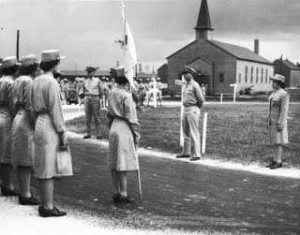 In the 1943 yearbook for Buckingham AAF, there is a passage which states: “And when this war is all over, Buckingham in all probability will be abandoned; its construction and buildings are temporary. But the men who have trained here will never forget the valuable things they have learned, and in the months ahead the Nazis and the Japs will come to know better and better the accuracy of guns aimed by Buckingham men.” Buckingham Field was indeed abandoned after the war and today the former Buckingham Field serves as the Lee County Mosquito Control District (LCMCD) airfield and office. World War II period maps, photographs and annuals may be viewed at the LCMCD office with prior arrangement.
In the 1943 yearbook for Buckingham AAF, there is a passage which states: “And when this war is all over, Buckingham in all probability will be abandoned; its construction and buildings are temporary. But the men who have trained here will never forget the valuable things they have learned, and in the months ahead the Nazis and the Japs will come to know better and better the accuracy of guns aimed by Buckingham men.” Buckingham Field was indeed abandoned after the war and today the former Buckingham Field serves as the Lee County Mosquito Control District (LCMCD) airfield and office. World War II period maps, photographs and annuals may be viewed at the LCMCD office with prior arrangement.
 Buckingham is the subject of a 2010 book by Chris Wadsworth and Matt Johnson that explores the rich history of the base. Titled simply Buckingham Army Air Field, the tome is available in paperback on Amazon.com. It is filled with great stories, fascinating facts and nearly 200 historic World War II era photos. One shows film icon Judy Garland visiting Buckingham Army Air Field. She and many other Hollywood stars supported the troops through morale boosting visits and concerts during the war years.
Buckingham is the subject of a 2010 book by Chris Wadsworth and Matt Johnson that explores the rich history of the base. Titled simply Buckingham Army Air Field, the tome is available in paperback on Amazon.com. It is filled with great stories, fascinating facts and nearly 200 historic World War II era photos. One shows film icon Judy Garland visiting Buckingham Army Air Field. She and many other Hollywood stars supported the troops through morale boosting visits and concerts during the war years.
 The legacy of BAAF helped shape the community long after the base was closed as a number of the airmen who trained at Buckingham returned and made homes in Fort Myers after the war. One was Wilbur “Bill” Smith. While training at BAAF, Smith met his wife and the couple settled in Fort Myers after the war, going on to open a successful chain of stores called Bill Smith Appliances.
The legacy of BAAF helped shape the community long after the base was closed as a number of the airmen who trained at Buckingham returned and made homes in Fort Myers after the war. One was Wilbur “Bill” Smith. While training at BAAF, Smith met his wife and the couple settled in Fort Myers after the war, going on to open a successful chain of stores called Bill Smith Appliances.
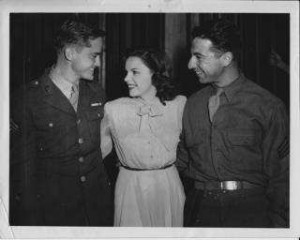 Another businessman with connections to Buckingham was Tommy Doyle of Flint & Doyle Structural Movers. Doyle was in the Army Air Corp. ferrying planes from Buckingham Army Air Base to Altus, Oklahoma for storage. He too stayed in the area after his discharge, and his experience moving planes helped Flint & Doyle become one of the leading structural moving company’s in the United States.
Another businessman with connections to Buckingham was Tommy Doyle of Flint & Doyle Structural Movers. Doyle was in the Army Air Corp. ferrying planes from Buckingham Army Air Base to Altus, Oklahoma for storage. He too stayed in the area after his discharge, and his experience moving planes helped Flint & Doyle become one of the leading structural moving company’s in the United States.
For those who have an interest in learning more about this period of Fort Myers’ history, the archives at the Southwest Florida Museum of History in downtown Fort Myers contains photos of many of the airmen who trained at Buckingham and Page Fields.
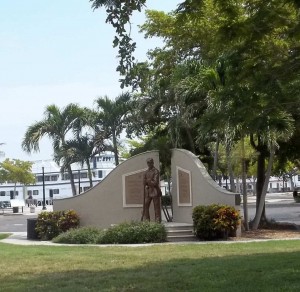 Fifth Stop: Clayton. Walk east across the wide grass mall and you will come upon yet another of D.J. Wilkins’ sculptures. This one is named Clayton, and it features a life-size bronze of a sergeant in the United States Colored Troops 2nd Regiment standing before a wall within a gate. The gate symbolizes freedom from slavery. The soldier memorializes all African Americans who served during the Civil War.
Fifth Stop: Clayton. Walk east across the wide grass mall and you will come upon yet another of D.J. Wilkins’ sculptures. This one is named Clayton, and it features a life-size bronze of a sergeant in the United States Colored Troops 2nd Regiment standing before a wall within a gate. The gate symbolizes freedom from slavery. The soldier memorializes all African Americans who served during the Civil War.
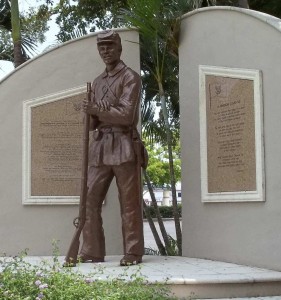 The soldier is framed by two plaques. The one on the left is the dedication. It contains a four sentence summary of the battle fought on February 20, 1865 in which Union forces anchored by members of the USCT repelled an attack by Confederates sent to destroy the fort and capture some 4,000 head of cattle needed by the Confederacy to feed its last contingent of fighting forces making their way toward Appomattox. The marble inscription also notes that during their tour in southwest Florida, USCT troops freed and enlisted more than 1,000 slaves who had been toiling in the fields and ranches in this part of the South.
The soldier is framed by two plaques. The one on the left is the dedication. It contains a four sentence summary of the battle fought on February 20, 1865 in which Union forces anchored by members of the USCT repelled an attack by Confederates sent to destroy the fort and capture some 4,000 head of cattle needed by the Confederacy to feed its last contingent of fighting forces making their way toward Appomattox. The marble inscription also notes that during their tour in southwest Florida, USCT troops freed and enlisted more than 1,000 slaves who had been toiling in the fields and ranches in this part of the South.
The plaque on the right contains a poem entitled “In Freedom Cover Me” which Wilkins wrote and ascribed to the soldier.
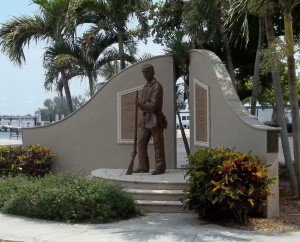 Wilkins named the soldier in his memorial Clayton because “it took a ton of clay to sculpt the statue.” It was dedicated 135 years after the Battle of Fort Myers and is a reminder of the rich historical heritage that we enjoy here in Lee County and the City of Fort Myers. “People don’t have a sense of connection, a sense of history here because so many folks are from elsewhere,” muses sculptor D.J. Wilkins. “But American history started right here, with footprints of the Conquistadors in the sands of Florida. And Fort Myers has the distinction of being the site of the southernmost battle of the Civil War, an engagement won due to the bravery of the men who fought in the 2nd Regiment of the USCT.” The acronym stands for the United States Colored Troops, and in 2000, the City of Fort Myers commissioned Wilkins to create a tribute to their gallantry.
Wilkins named the soldier in his memorial Clayton because “it took a ton of clay to sculpt the statue.” It was dedicated 135 years after the Battle of Fort Myers and is a reminder of the rich historical heritage that we enjoy here in Lee County and the City of Fort Myers. “People don’t have a sense of connection, a sense of history here because so many folks are from elsewhere,” muses sculptor D.J. Wilkins. “But American history started right here, with footprints of the Conquistadors in the sands of Florida. And Fort Myers has the distinction of being the site of the southernmost battle of the Civil War, an engagement won due to the bravery of the men who fought in the 2nd Regiment of the USCT.” The acronym stands for the United States Colored Troops, and in 2000, the City of Fort Myers commissioned Wilkins to create a tribute to their gallantry.
[If you’d like to know more about Clayton or read an account of the Battle of Fort Myers waged on February 20, 1865, please visit http://www.artswfl.com/galleries/fort-myers-river-district/public-art-installations/clayton/clayton.]
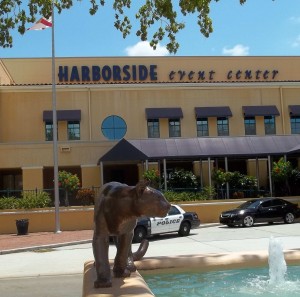 Sixth Stop: The Florida Panther. Now head back to the entrance of Centennial Park and head south on Monroe Street. As you draw alongside the Harborside Event Center, you’ll discover yet another of D.J. Wilkins’ public artworks, the Florida Panther. Located in the median, the installation consists of a long (approximately 50 foot), rectangular-shaped fountain with two basins, separated by a large planter. An adult male panther prowls atop one basin. At the other basin, an adult female panther reclines at one corner, while a panther cub rests at another across the basin from her. Near the cub is a frog. Each basin has an electric pump, and water cascades from each into a receiving pool. The panthers and the frog are made of cold cast bronze. The basins consist of poured concrete and cast stone. The installation was dedicated October 22, 1988.
Sixth Stop: The Florida Panther. Now head back to the entrance of Centennial Park and head south on Monroe Street. As you draw alongside the Harborside Event Center, you’ll discover yet another of D.J. Wilkins’ public artworks, the Florida Panther. Located in the median, the installation consists of a long (approximately 50 foot), rectangular-shaped fountain with two basins, separated by a large planter. An adult male panther prowls atop one basin. At the other basin, an adult female panther reclines at one corner, while a panther cub rests at another across the basin from her. Near the cub is a frog. Each basin has an electric pump, and water cascades from each into a receiving pool. The panthers and the frog are made of cold cast bronze. The basins consist of poured concrete and cast stone. The installation was dedicated October 22, 1988.
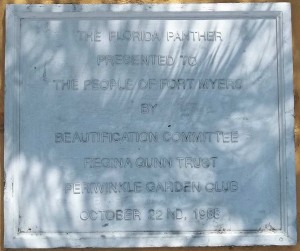 Two plaques are mounted on the fountain. One is its dedication; the other warns that the panther is on a countdown to extinction. A subspecies of mountain lions, the Florida Panther is one of the most endangered large mammals in the world today. A small population in South Florida, estimated to number between 30 and 50 adults (30 to 80 total individuals), represents the only known remaining wild population of an animal that once ranged throughout most of the southeastern United States from Arkansas and Louisiana eastward across Mississippi, Alabama, Georgia, Florida and parts of South Carolina and Tennessee. The panther presently occupies one of the least developed areas in the eastern United States; a contiguous system of large private ranches and public conservation lands in Lee, Collier, Glades, Hendry, Palm Beach, Broward, Miami-Dade and Monroe counties totaling more than 809,400 acres.
Two plaques are mounted on the fountain. One is its dedication; the other warns that the panther is on a countdown to extinction. A subspecies of mountain lions, the Florida Panther is one of the most endangered large mammals in the world today. A small population in South Florida, estimated to number between 30 and 50 adults (30 to 80 total individuals), represents the only known remaining wild population of an animal that once ranged throughout most of the southeastern United States from Arkansas and Louisiana eastward across Mississippi, Alabama, Georgia, Florida and parts of South Carolina and Tennessee. The panther presently occupies one of the least developed areas in the eastern United States; a contiguous system of large private ranches and public conservation lands in Lee, Collier, Glades, Hendry, Palm Beach, Broward, Miami-Dade and Monroe counties totaling more than 809,400 acres.
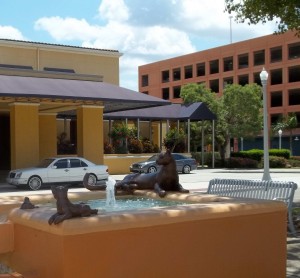 Population viability projections conducted in the early ’90s concluded that the panther would probably become extinct within two to four decades because of inbreeding alone, so eight female Texas cougars were introduced into South Florida in 1995. That notwithstanding, the survival and recovery of the Florida panther is dependent upon protection of the small, remaining population, its habitats and prey resources. Both the city and the sculptor hope that The Florida Panther helps draw attention to the plight of this endangered species, which is Florida’s state animal.
Population viability projections conducted in the early ’90s concluded that the panther would probably become extinct within two to four decades because of inbreeding alone, so eight female Texas cougars were introduced into South Florida in 1995. That notwithstanding, the survival and recovery of the Florida panther is dependent upon protection of the small, remaining population, its habitats and prey resources. Both the city and the sculptor hope that The Florida Panther helps draw attention to the plight of this endangered species, which is Florida’s state animal.
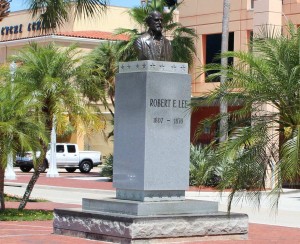 Seventh Stop: The Robert E. Lee Bust. Continue south on Monroe and you will quickly come upon a bust of Robert E. Lee. The creation, erection and dedication of the bust and its pedestal in 1966 was sponsored by the Fort Myers chapter of the United Daughters of the Confederacy, with the assistance of the citizens of Lee County.
Seventh Stop: The Robert E. Lee Bust. Continue south on Monroe and you will quickly come upon a bust of Robert E. Lee. The creation, erection and dedication of the bust and its pedestal in 1966 was sponsored by the Fort Myers chapter of the United Daughters of the Confederacy, with the assistance of the citizens of Lee County.
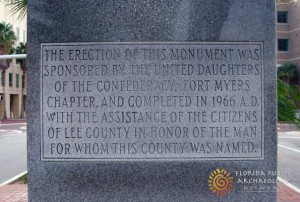 When the county was established on May 2, 1887, it was named after General Lee. Prior to that time, what is now Lee, Collier and Hendry counties were all part of Monroe County, but when politicians in the far-removed county seat of Key West refused to allocate funds to rebuild the local high school after it burned down, the tri-county area decided to break away and form its own local government. Francis Asbury Hendry moved to name the new county after Lee, “a distinguished and laudable character whom the world has esteemed and delights to honor.” Lee was certainly one of the most famous people in the South at that time, and was even highly regarded in the North. (Collier and Hendry later established their own local governments in 1923, with the former being named after Barron Collier and the later after Francis Asbury Hendry.)
When the county was established on May 2, 1887, it was named after General Lee. Prior to that time, what is now Lee, Collier and Hendry counties were all part of Monroe County, but when politicians in the far-removed county seat of Key West refused to allocate funds to rebuild the local high school after it burned down, the tri-county area decided to break away and form its own local government. Francis Asbury Hendry moved to name the new county after Lee, “a distinguished and laudable character whom the world has esteemed and delights to honor.” Lee was certainly one of the most famous people in the South at that time, and was even highly regarded in the North. (Collier and Hendry later established their own local governments in 1923, with the former being named after Barron Collier and the later after Francis Asbury Hendry.)
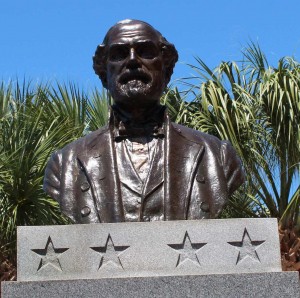 It is doubtful that Lee ever actually set foot in what is today Fort Myers. He certainly did not visit the area during the Civil War as the fort on the banks of the Caloosahatchee (which was located on the site now occupied by the Sidney & Berne Davis Art Center) was a Union outpost occupied by elements of the 2nd Regiment of the USTC, to whom Clayton is dedicated. (And ironically, Hendry rode with the Cow Calvary that attacked Fort Myers and was repelled by the 2nd Regiment in the battle of February 20, 1865.)
It is doubtful that Lee ever actually set foot in what is today Fort Myers. He certainly did not visit the area during the Civil War as the fort on the banks of the Caloosahatchee (which was located on the site now occupied by the Sidney & Berne Davis Art Center) was a Union outpost occupied by elements of the 2nd Regiment of the USTC, to whom Clayton is dedicated. (And ironically, Hendry rode with the Cow Calvary that attacked Fort Myers and was repelled by the 2nd Regiment in the battle of February 20, 1865.)
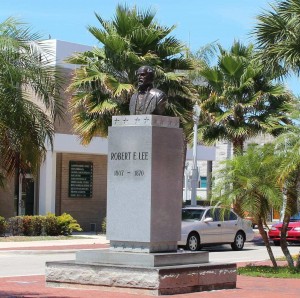 But it is possible that Lee visited Sanibel Island in 1849 when he toured large swaths of Florida as an army engineer during the period when the third order of coastal defenses was being constructed. To date, however, no one has been able to confirm his visit. Unfortunately, none of the letters Lee wrote home during his months-long boat tour of the Florida coastline survived and the official records of Lee’s 1849 tour across Florida were lost in a fire at the War Department several years later.
But it is possible that Lee visited Sanibel Island in 1849 when he toured large swaths of Florida as an army engineer during the period when the third order of coastal defenses was being constructed. To date, however, no one has been able to confirm his visit. Unfortunately, none of the letters Lee wrote home during his months-long boat tour of the Florida coastline survived and the official records of Lee’s 1849 tour across Florida were lost in a fire at the War Department several years later.
The bust is not the only tribute to Lee located within the city of Fort Myers. There is also a mosaic of Robert E. Lee and his almost as famous horse, Traveller, in the alcove of the Lee County Bank on Hendry and First Street.
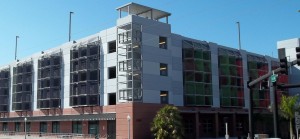 Eighth Stop: Parallel Park. Continue south on Monroe past the Lee County Justice Center. When you reach the intersection of Monroe and Martin Luther King, Jr. Boulevard, look slightly right (2 o’clock), and you will be gazing at a 5-story parking garage. In most places, utilitarian concrete parking garages blight rather than enhance urban environments, but Parallel Park has transformed the Lee County Justice Center Parking Garage into a work of fine art that has first time visitors asking “Is this the fine art museum?”
Eighth Stop: Parallel Park. Continue south on Monroe past the Lee County Justice Center. When you reach the intersection of Monroe and Martin Luther King, Jr. Boulevard, look slightly right (2 o’clock), and you will be gazing at a 5-story parking garage. In most places, utilitarian concrete parking garages blight rather than enhance urban environments, but Parallel Park has transformed the Lee County Justice Center Parking Garage into a work of fine art that has first time visitors asking “Is this the fine art museum?”
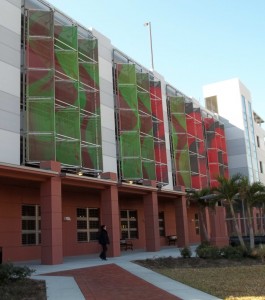 Dedicated on December 9, 2010, Parallel Park is a site-specific 30,000 square foot outdoor art installation. It consists of 23 open-weave Kevlar and fiberglass fabric panels that have been attached to the exterior of the Lee County Justice Center Parking Garage by tubular aluminum and steel rods. Each panel stands an astounding 33 feet tall by 22 feet wide and the images change right before the viewer’s eyes as the sun carves its daily arc and clouds scurry across the bright blue Florida sky.
Dedicated on December 9, 2010, Parallel Park is a site-specific 30,000 square foot outdoor art installation. It consists of 23 open-weave Kevlar and fiberglass fabric panels that have been attached to the exterior of the Lee County Justice Center Parking Garage by tubular aluminum and steel rods. Each panel stands an astounding 33 feet tall by 22 feet wide and the images change right before the viewer’s eyes as the sun carves its daily arc and clouds scurry across the bright blue Florida sky.
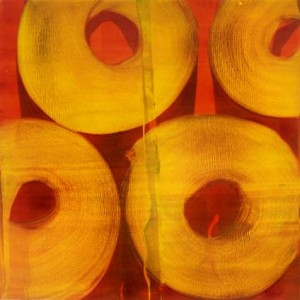 The panels are blow-ups of abstract paintings that artist Marylyn Dintenfass created in her New York studio. Dintenfass began by creating 23 oil-on-paper monotypes, each 35 inches square. Each monotype was then photographed, drum-scanned and enlarged to ten times its original size using specialized digitizing software. The resulting images were then printed on massive 33’ x 22’ open-weave Kevlar and fiberglass fabric panels using archival ink which was then coated with a protective ultraviolet screening to ensure long-life durability.
The panels are blow-ups of abstract paintings that artist Marylyn Dintenfass created in her New York studio. Dintenfass began by creating 23 oil-on-paper monotypes, each 35 inches square. Each monotype was then photographed, drum-scanned and enlarged to ten times its original size using specialized digitizing software. The resulting images were then printed on massive 33’ x 22’ open-weave Kevlar and fiberglass fabric panels using archival ink which was then coated with a protective ultraviolet screening to ensure long-life durability.
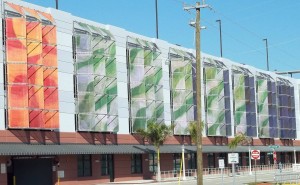 The panels engage the viewer kinetically, but they also tell a story. Each side of the building represents a new chapter, but by the time you circle the building, the sun and clouds have changed position, and you are presented with four new chapters in this never-ending story. The characters in Dintenfass’ novel are shape, scale, pattern and (to quote filmmaker Julie Mintz) “crazy colors … outside the natural palette.” Dintenfass lays yellow-oranges alongside crimson red like a Good Humor bomb pop, and she distills her greens from forest moss and ocean plankton.
The panels engage the viewer kinetically, but they also tell a story. Each side of the building represents a new chapter, but by the time you circle the building, the sun and clouds have changed position, and you are presented with four new chapters in this never-ending story. The characters in Dintenfass’ novel are shape, scale, pattern and (to quote filmmaker Julie Mintz) “crazy colors … outside the natural palette.” Dintenfass lays yellow-oranges alongside crimson red like a Good Humor bomb pop, and she distills her greens from forest moss and ocean plankton.
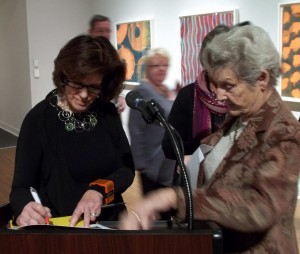 Taken together, the 23 panels “metaphorically express the spirit of the automobile.” It’s a subject with which Dintenfass has had a love affair since before the time she could drive. “The circle shapes conjure tires, headlights, dashboard instrumentation and steering wheels,” Marylyn explains. “Linear patterns are emblematic of roads, ramps, directions and parking designations.” Dintenfass’ iconography of postwar American automotive culture directly integrates her interpretation of mobility and space with the fundamental purpose of a parking garage. It’s an apt simile given that Fort Myers’ was the winter home of Henry Ford and Harvey Firestone, two of the leading pioneers of the American automobile industry.
Taken together, the 23 panels “metaphorically express the spirit of the automobile.” It’s a subject with which Dintenfass has had a love affair since before the time she could drive. “The circle shapes conjure tires, headlights, dashboard instrumentation and steering wheels,” Marylyn explains. “Linear patterns are emblematic of roads, ramps, directions and parking designations.” Dintenfass’ iconography of postwar American automotive culture directly integrates her interpretation of mobility and space with the fundamental purpose of a parking garage. It’s an apt simile given that Fort Myers’ was the winter home of Henry Ford and Harvey Firestone, two of the leading pioneers of the American automobile industry.
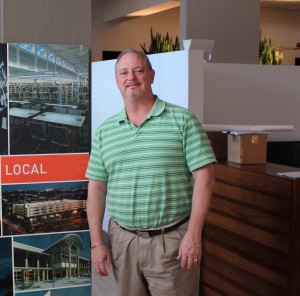 The installation was the brainchild of local architect Kevin Williams, who opted to use art panels consisting of open-weave Kevlar fabric to comply with a building ordinance that requires that parked cars be obscured from public view. “I was familiar with the material from Europe, where they use it in historical preservation,” Williams explains. “The saw tooth pattern of the tubular attachments holds the panels on even in high winds, facilitates air circulation and ventilation inside the structure, and permits people to view the artwork up close as well as from a distance.” Converting Williams’ design concept into reality was a collaborative effort between Lee County, the City of Fort Myers Public Art Committee, art consultant Barbara Hill, New York abstract artist Marylyn Dintenfass, a printer located in North Carolina and a fabricator in Orlando, with the artist’s New York gallery, Babcock Galleries, providing publicity and media relations.
The installation was the brainchild of local architect Kevin Williams, who opted to use art panels consisting of open-weave Kevlar fabric to comply with a building ordinance that requires that parked cars be obscured from public view. “I was familiar with the material from Europe, where they use it in historical preservation,” Williams explains. “The saw tooth pattern of the tubular attachments holds the panels on even in high winds, facilitates air circulation and ventilation inside the structure, and permits people to view the artwork up close as well as from a distance.” Converting Williams’ design concept into reality was a collaborative effort between Lee County, the City of Fort Myers Public Art Committee, art consultant Barbara Hill, New York abstract artist Marylyn Dintenfass, a printer located in North Carolina and a fabricator in Orlando, with the artist’s New York gallery, Babcock Galleries, providing publicity and media relations.
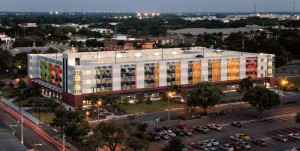 Parallel Park has brought a considerable amount of national and international attention to Fort Myers since its dedication in December of 2o10. The making of Parallel Park is the subject of a new book by author Eliza Edelman. Released October 11, 2011, the Hard Press Editions/Hudson Hills Press monograph entitled Marylyn Dintenfass Parallel Park details the conception, planning and installation of the monumental art project. The book’s release was followed by an article on Parallel Park in ArtNews Magazine, which has a worldwide subscriber base of more than 200,000 readers.
Parallel Park has brought a considerable amount of national and international attention to Fort Myers since its dedication in December of 2o10. The making of Parallel Park is the subject of a new book by author Eliza Edelman. Released October 11, 2011, the Hard Press Editions/Hudson Hills Press monograph entitled Marylyn Dintenfass Parallel Park details the conception, planning and installation of the monumental art project. The book’s release was followed by an article on Parallel Park in ArtNews Magazine, which has a worldwide subscriber base of more than 200,000 readers.
[If you’d like to know more about Parallel Park, Marylyn Dintenfass or the book on the project, please visit http://www.artswfl.com/galleries/fort-myers-river-district/public-art-installations/parallel-park/parallel-park.]
Ninth Stop: Marlin Miller American Bald Eagle.
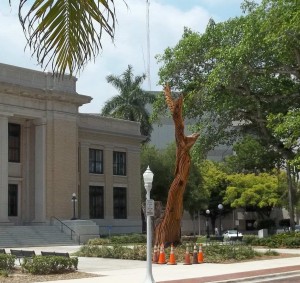 To truly appreciate Parallel Park, you should walk completely around the parking garage. But whether you circle the parking garage or simply survey Parallel Park from the corner of Monroe and MLK, when you are done admiring Marylyn Dintenfass’ abstract expressionist art panels, head east on MLK and then hang a left on Broadway. After you will pass the Veranda Restaurant, you will come upon the old Lee County Courthouse where Broadway intersects Main Street. That’s where you’ll find a two-story sculpture of a soaring American bald eagle. It was carved by chainsaw artist Marlin Miller from a 200-year-old oak tree that had become infested with termites and was scheduled to be cut down. Miller offered to carve the eagle gratis, asking the county to merely pick up the cost of his out-of-pocket expenses. It was an offer too good to pass up.
To truly appreciate Parallel Park, you should walk completely around the parking garage. But whether you circle the parking garage or simply survey Parallel Park from the corner of Monroe and MLK, when you are done admiring Marylyn Dintenfass’ abstract expressionist art panels, head east on MLK and then hang a left on Broadway. After you will pass the Veranda Restaurant, you will come upon the old Lee County Courthouse where Broadway intersects Main Street. That’s where you’ll find a two-story sculpture of a soaring American bald eagle. It was carved by chainsaw artist Marlin Miller from a 200-year-old oak tree that had become infested with termites and was scheduled to be cut down. Miller offered to carve the eagle gratis, asking the county to merely pick up the cost of his out-of-pocket expenses. It was an offer too good to pass up.
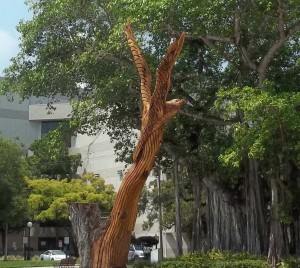 Perched high above ground in the carriage of a hydraulic lift, Miller used a chain saw to shave huge chunks of bark and wood from the trunk of the termite infested tree. He started the project on June 9, 2011 and completed it in just five days on June 14th. “It is heavily reinforced to withstand a hundred years of anything mother nature throws its way,” Miller said after completing the wood sculpture, which towers more than two stories into the air.
Perched high above ground in the carriage of a hydraulic lift, Miller used a chain saw to shave huge chunks of bark and wood from the trunk of the termite infested tree. He started the project on June 9, 2011 and completed it in just five days on June 14th. “It is heavily reinforced to withstand a hundred years of anything mother nature throws its way,” Miller said after completing the wood sculpture, which towers more than two stories into the air.
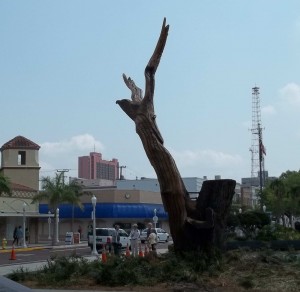 Miller has a history of salvaging trees ravaged by time and storm. For three years, he donated his time and talent carving a trail of “Katrina Sculptures” along a 40-mile stretch of Mississippi coastline from the trunks of immense oak trees ravaged by the killer storm. During that span, Miller completed more than 30 perched pelicans, soaring eagles and playful dolphins, some towering three stories high. Fifteen of these are in Biloxi and now serve both as tourist attractions and poignant reminders that our native animal and marine life are irreplaceable local treasures. Miller has been featured on the NBC Nightly News with Brian Williams, The Today Show and CNN. His work has been featured in Southern Living Magazine, Coastal Living, Southern Breeze and Woodcarving Illustrated.
Miller has a history of salvaging trees ravaged by time and storm. For three years, he donated his time and talent carving a trail of “Katrina Sculptures” along a 40-mile stretch of Mississippi coastline from the trunks of immense oak trees ravaged by the killer storm. During that span, Miller completed more than 30 perched pelicans, soaring eagles and playful dolphins, some towering three stories high. Fifteen of these are in Biloxi and now serve both as tourist attractions and poignant reminders that our native animal and marine life are irreplaceable local treasures. Miller has been featured on the NBC Nightly News with Brian Williams, The Today Show and CNN. His work has been featured in Southern Living Magazine, Coastal Living, Southern Breeze and Woodcarving Illustrated.
[If you’d like to know more about the old 200-year-old oak, Marlin Miller or his American bald eagle, please visit http://www.artswfl.com/galleries/fort-myers-river-district/public-art-installations/marlin-miller-american-bald-eagle/marlin-miller-american-bald-eagle.]
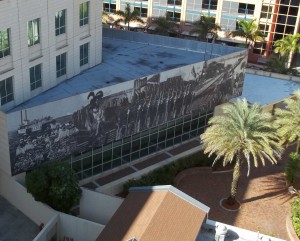 Tenth Stop: Barbara Jo Revelle Ceramic Tile Mural. Cross Main Street and continue south on Broadway, past daas Gallery, until you come to the entrance to Hotel Indigo. As you pass through the glass doors, you will be standing in the 1927 arcade that once served as the U.S. Post Office. Today, the arcade is home to Vino de Notte and Ichiban Chinese and Japanese restaurants. Turn left at the end of the arcade, and you’ll find yourself in the lobby of Hotel Indigo, Fort Myers’ most exclusive boutique hotel. Part of the InterContinental Hotel Group, the hotel is known for plush guest rooms and swank public spaces that are transformed seasonally through changing signage, aromas, music and artwork. But while there is much to see and admire in Hotel Indigo (such as Leoma Lovegrove’s van Goghs and David Acevedo’s mural in the rooftop lounge), this is a tour of the public artworks located within the River District. So turn right at the end of the arcade and exit into the courtyard that’s shared by Hotel Indigo, the new federal courthouse and HOWL Gallery/Tattoo. This is where you will find Fort Myers: An Alternative History.
Tenth Stop: Barbara Jo Revelle Ceramic Tile Mural. Cross Main Street and continue south on Broadway, past daas Gallery, until you come to the entrance to Hotel Indigo. As you pass through the glass doors, you will be standing in the 1927 arcade that once served as the U.S. Post Office. Today, the arcade is home to Vino de Notte and Ichiban Chinese and Japanese restaurants. Turn left at the end of the arcade, and you’ll find yourself in the lobby of Hotel Indigo, Fort Myers’ most exclusive boutique hotel. Part of the InterContinental Hotel Group, the hotel is known for plush guest rooms and swank public spaces that are transformed seasonally through changing signage, aromas, music and artwork. But while there is much to see and admire in Hotel Indigo (such as Leoma Lovegrove’s van Goghs and David Acevedo’s mural in the rooftop lounge), this is a tour of the public artworks located within the River District. So turn right at the end of the arcade and exit into the courtyard that’s shared by Hotel Indigo, the new federal courthouse and HOWL Gallery/Tattoo. This is where you will find Fort Myers: An Alternative History.
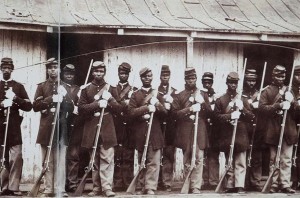 Standing 20 feet tall by 100 feet wide, the mural pays homage to Fort Myers’ heritage as an outpost in the Seminole Wars, the site of the southernmost battle in the Civil War, and as a 19th century cattle town. To create Fort Myers: An Alternative History, [then] University of Florida photography dean Barbara Jo Revelle spent two years pouring over historical documents and treatises, including James W. Covington’s The Seminoles of Florida, Karl H. Grismer’s The Story of Fort Myers and The New History of Fort Myers, edited by Michael Gannon. She created vanilla folders for Seminole Chief Billy Bowlegs, the Seminole Indians, the fort built along the banks of the Caloosahatchee River during the Seminole Wars, and the soldiers of Companies D & I of the 2nd Regiment of the United States Colored Troops which occupied and defended the fort during the waning days of the Civil War in what turned out to be the southernmost engagement of that conflict. The USCT was assigned to the fort in order to prevent the shipment of cattle to Confederate troops fighting in Georgia by ranchers who had established a bustling cattle ranching industry prior to the South’s cessation from the United States.
Standing 20 feet tall by 100 feet wide, the mural pays homage to Fort Myers’ heritage as an outpost in the Seminole Wars, the site of the southernmost battle in the Civil War, and as a 19th century cattle town. To create Fort Myers: An Alternative History, [then] University of Florida photography dean Barbara Jo Revelle spent two years pouring over historical documents and treatises, including James W. Covington’s The Seminoles of Florida, Karl H. Grismer’s The Story of Fort Myers and The New History of Fort Myers, edited by Michael Gannon. She created vanilla folders for Seminole Chief Billy Bowlegs, the Seminole Indians, the fort built along the banks of the Caloosahatchee River during the Seminole Wars, and the soldiers of Companies D & I of the 2nd Regiment of the United States Colored Troops which occupied and defended the fort during the waning days of the Civil War in what turned out to be the southernmost engagement of that conflict. The USCT was assigned to the fort in order to prevent the shipment of cattle to Confederate troops fighting in Georgia by ranchers who had established a bustling cattle ranching industry prior to the South’s cessation from the United States.
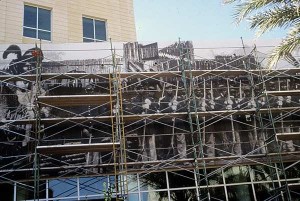 Revelle digitized the photographs and then transferred the digital prints to thousands of ceramic tiles using print technologies considered innovative in the 1990s. The resulting sepia-toned graded mosaic tiles then had to be affixed to the pre-cast concrete walls of the courthouse by masons using a master digital montage print-out like the blueprint to an immense jigsaw puzzle.
Revelle digitized the photographs and then transferred the digital prints to thousands of ceramic tiles using print technologies considered innovative in the 1990s. The resulting sepia-toned graded mosaic tiles then had to be affixed to the pre-cast concrete walls of the courthouse by masons using a master digital montage print-out like the blueprint to an immense jigsaw puzzle.
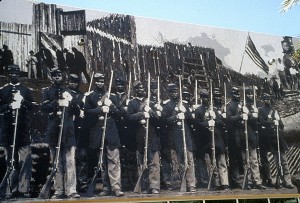 The installation required the same techniques and preparation that swimming pool contractors use when installing ceramic tile accents to a pool or water feature. Revelle recommended that the smooth precast concrete be sandblasted “immediately prior to the installation to fully clean the surface,” which needed to be devoid of oil and release agents. Working from an intricate network of scaffolds, the masons then applied a 1/8th inch thick coat of skim coat to the concrete substrate before bedding the tiles in thin-set latex-modified Portland cement mortar. These practices were required as a precaution against cracking in the torrid temperatures that the surface of the mural can reach during afternoons in the blazing southwest Florida sun.
The installation required the same techniques and preparation that swimming pool contractors use when installing ceramic tile accents to a pool or water feature. Revelle recommended that the smooth precast concrete be sandblasted “immediately prior to the installation to fully clean the surface,” which needed to be devoid of oil and release agents. Working from an intricate network of scaffolds, the masons then applied a 1/8th inch thick coat of skim coat to the concrete substrate before bedding the tiles in thin-set latex-modified Portland cement mortar. These practices were required as a precaution against cracking in the torrid temperatures that the surface of the mural can reach during afternoons in the blazing southwest Florida sun.
The result is a breathtaking mural that pictorially chronicles a relatively brief 15-year span framed by the founding of Fort Myers in 1850 as an outpost following the Second Seminole War and its decommissioning as a federal encampment in March of 1865, just weeks after elements of the 2nd Regiment of the U.S. Colored Troops and the 11o New York Army had repelled a last-ditch attack by the Cow Calvary to destroy the fort and seize 4,000 head of cattle needed by Lee in order to feed the remnants of his Army as they made their way to Appomattox.
[If you’d like to know more about the mural or Barbara Jo Revelle, please visit http://www.artswfl.com/galleries/fort-myers-river-district/public-art-installations/barbara-jo-revelle-ceramic-tile-mural/barbara-jo-revelle-ceramic-tile-mural.]
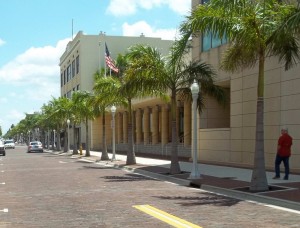 11th Stop: Streetscape. The next “stop” isn’t really a stop at all. It’s more of an observation to be made as you exit the courtyard onto First Street, and head east toward the Sidney & Berne Davis Art Center at First and Jackson. As you walk along first, notice the bricked streets, low aspect curbs and broad sidewalks. They are all part of a 4-year utility and beautification project known as Streetscape. It was part of an ambitious project that involved removing and replacing all the underground utilities and streets in the 52 block core area of the downtown Fort Myers River District.
11th Stop: Streetscape. The next “stop” isn’t really a stop at all. It’s more of an observation to be made as you exit the courtyard onto First Street, and head east toward the Sidney & Berne Davis Art Center at First and Jackson. As you walk along first, notice the bricked streets, low aspect curbs and broad sidewalks. They are all part of a 4-year utility and beautification project known as Streetscape. It was part of an ambitious project that involved removing and replacing all the underground utilities and streets in the 52 block core area of the downtown Fort Myers River District.
Above ground, the streets were narrowed, street profiles lowered and sidewalks broadened to accommodate both increased foot traffic and café-style dining by streetside restaurants and bistros. Brick-accented sidewalks and crosswalks, landscaping and lighting were added. Smaller, more historic traffic signals, park benches, unobtrusive waste receptacles, decorative bike racks and landscaping were employed to enhance the downtown’s charm and ambiance.
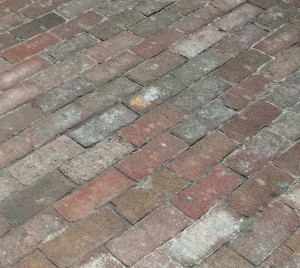 Prior to the Streetscape project, the roads throughout the River District were covered in asphalt. But the asphalt had been laid over thousands of old bricks. The Downtown Fort Myers Redevelopment Agency decided to recover and recycle more than 500,000 of these bricks because of their historic significance. Today, those bricks not only pave the streets and crosswalks, they surface many of the sidewalks and plazas throughout the downtown Fort Myers River District.
Prior to the Streetscape project, the roads throughout the River District were covered in asphalt. But the asphalt had been laid over thousands of old bricks. The Downtown Fort Myers Redevelopment Agency decided to recover and recycle more than 500,000 of these bricks because of their historic significance. Today, those bricks not only pave the streets and crosswalks, they surface many of the sidewalks and plazas throughout the downtown Fort Myers River District.
The City of Fort Myers’ Downtown Utility and Streetscape Improvements Project received the Project of the Year Award in the Historical Restoration/Preservation category from the Florida Chapter Awards Committee of the American Public Works Association (APWA), beating out 79 other projects submitted for consideration. The project has drawn national attention, as well. “I received a call from Wrangler Jeans,” Redevelopment Agency Executive Director Don Paight recalls. “They’d been scouting locations to do some of their catalogs and commercials and absolutely fell in love with downtown Fort Myers. They said it was like a Hollywood stage set. They sent a crew down here and spent four days in front of the businesses, along the brick streets, down along the waterfront. We’re hoping to attract more of that type of activity.”
The importance of Streetscape to the River District’s emerging reputation as a cultural center cannot be overstated. The project was critically important not only to establishing the infrastructure needed by arts organizations such as Art of the Olympians, the Sidney & Berne Davis Art Center and the Florida Repertory Theatre and the art galleries who have made the downtown their home, but the new streets, sidewalks and other accouterments were necessary to provide a venue for events such as Art Walk and Music Walk.
[If you’d like to know more about the Streetscape project, please visit http://www.artswfl.com/galleries/fort-myers-river-district/public-art-installations/streetscape/streetscape.]
 12th Stop: Patio de Leon Fountains. After you pass Dean Street, you will come upon the First Street entrance to Patio de Leon. At the entrance is a fountain with a lion’s head on it, from which Patio de Leon takes its name. The “court” was developed by a retired banker from Benton Harbor, Michigan by the name of Peter Tonneliar. Between 1913 and 1915, he erected most of the buildings in the courtyard, including a huge wooden Vaudeville theater known as the Ritz, which was located right next to the site presently occupied by Morgan House Restaurant. Next door neighbor, Space 39, occupies a building constructed in 1916 that served as the ticket office for the Ritz, which burned to the ground in 1925.
12th Stop: Patio de Leon Fountains. After you pass Dean Street, you will come upon the First Street entrance to Patio de Leon. At the entrance is a fountain with a lion’s head on it, from which Patio de Leon takes its name. The “court” was developed by a retired banker from Benton Harbor, Michigan by the name of Peter Tonneliar. Between 1913 and 1915, he erected most of the buildings in the courtyard, including a huge wooden Vaudeville theater known as the Ritz, which was located right next to the site presently occupied by Morgan House Restaurant. Next door neighbor, Space 39, occupies a building constructed in 1916 that served as the ticket office for the Ritz, which burned to the ground in 1925.
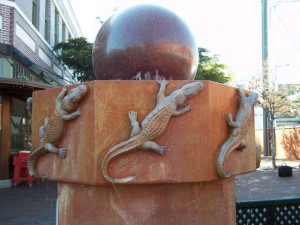 Today, Peter Tonneliar’s beautiful patio provides a soothing backdrop for relaxing and entertaining, and its centerpiece is a fountain that was once an alligator attraction, and a fruit and soda stand for much of the 1930s. It was redesigned in the ’90s and again in 2010. Today, the granite and stained concrete fountain has a rotating sphere and stone alligators that pay homage to the fountain’s early history.
Today, Peter Tonneliar’s beautiful patio provides a soothing backdrop for relaxing and entertaining, and its centerpiece is a fountain that was once an alligator attraction, and a fruit and soda stand for much of the 1930s. It was redesigned in the ’90s and again in 2010. Today, the granite and stained concrete fountain has a rotating sphere and stone alligators that pay homage to the fountain’s early history.
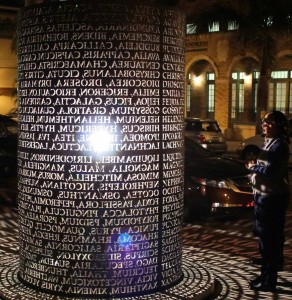 13th Stop: Caloosahatchee Manuscripts. At night, the tapered Ionic columns and limestone steps of the Sidney & Berne Davis Art Center glow with the images of thousands of letters like a phosphorous alphabet soup. The source of this bedazzling light show are two large bronze cylinders that sit on the sidewalk at the foot of SBDAC’s stairs. They are a dual point light sculpture called Caloosahatchee Manuscripts, a gift to the City of Fort Myers made in 2001 by Florida Power & Light Co.
13th Stop: Caloosahatchee Manuscripts. At night, the tapered Ionic columns and limestone steps of the Sidney & Berne Davis Art Center glow with the images of thousands of letters like a phosphorous alphabet soup. The source of this bedazzling light show are two large bronze cylinders that sit on the sidewalk at the foot of SBDAC’s stairs. They are a dual point light sculpture called Caloosahatchee Manuscripts, a gift to the City of Fort Myers made in 2001 by Florida Power & Light Co.
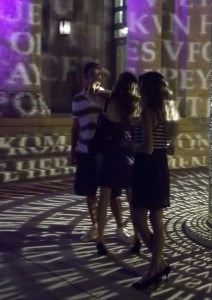 FPL commissioned the work to commemorate the conversion of its power plant on the south bank to the Caloosahatchee River from oil to natural gas. “In 1998, Florida Power & Light decided to re-power its Fort Myers power plant,” FPL spokesman Neil Nissan recalls. “It was built in the 1950s, and we weren’t using oil any more. So we converted the plant to natural gas, which is much cleaner and served to reduce the oil barge traffic on the river. We wanted to commemorate the occasion and asked the community what we should do.” In response, the city suggested a light sculpture by renowned artist Jim Sanborn.
FPL commissioned the work to commemorate the conversion of its power plant on the south bank to the Caloosahatchee River from oil to natural gas. “In 1998, Florida Power & Light decided to re-power its Fort Myers power plant,” FPL spokesman Neil Nissan recalls. “It was built in the 1950s, and we weren’t using oil any more. So we converted the plant to natural gas, which is much cleaner and served to reduce the oil barge traffic on the river. We wanted to commemorate the occasion and asked the community what we should do.” In response, the city suggested a light sculpture by renowned artist Jim Sanborn.
Caloosahatchee Manuscripts consists of two bronze cylinders roughly ten feet tall with a pinpoint light source in their center. Using a water jet cutter, sculptor Jim Sanborn incised letters into the bronze which are transferred to the façade, steps and sidewalks surrounding the art center at night.
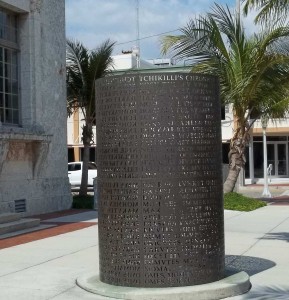 The eastern drum contains the text of a story told by Maskoki Indian leader Tchikilli to James Oglethorpe about the migration of Native Americans into the lower southeast, including Georgia (where Oglethorpe had founded his colony) and Florida. The Seminoles, Miccosukee and Creek trace their ancestry to Tchikilli and his people, and the Sidney & Berne Davis Art Center rests on the site of a settlement of Creek Indians that pre-dates the army fort which eventually gave birth to the city’s name.
The eastern drum contains the text of a story told by Maskoki Indian leader Tchikilli to James Oglethorpe about the migration of Native Americans into the lower southeast, including Georgia (where Oglethorpe had founded his colony) and Florida. The Seminoles, Miccosukee and Creek trace their ancestry to Tchikilli and his people, and the Sidney & Berne Davis Art Center rests on the site of a settlement of Creek Indians that pre-dates the army fort which eventually gave birth to the city’s name.
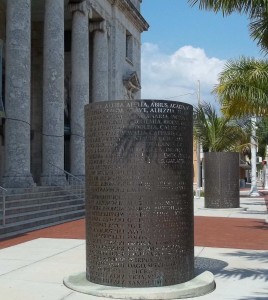 The western drum is no less historic. Into that cylinder, Sanborn incised the Latin names of 500 botanicals that Thomas Edison tested in an effort to develop a local source of latex from which to make rubber in order to help out his friends Henry Ford and Harvey Firestone. Latex is produced by many flowering plants, including dandelions (it’s the milky substance that bleeds from the stem when you pick one), gardenias, goldenrod, wisteria and yucca. Unfortunately, Edison died before he had successfully developed a local species that could rival the South American rubber tree.
The western drum is no less historic. Into that cylinder, Sanborn incised the Latin names of 500 botanicals that Thomas Edison tested in an effort to develop a local source of latex from which to make rubber in order to help out his friends Henry Ford and Harvey Firestone. Latex is produced by many flowering plants, including dandelions (it’s the milky substance that bleeds from the stem when you pick one), gardenias, goldenrod, wisteria and yucca. Unfortunately, Edison died before he had successfully developed a local species that could rival the South American rubber tree.
After completing Caloosahatchee Manuscripts, sculptor Jim Sanborn went on to complete several other site-specific public art installations including an incised copper and granite piece titled Comma that lights up the plaza in front of the new library at the University of Houston (2004) and bronze projection cylinders with waterjet cut text named Radiance at the Department of Energy, Coast and Environment at Lousiana State University (LSU) (2008).
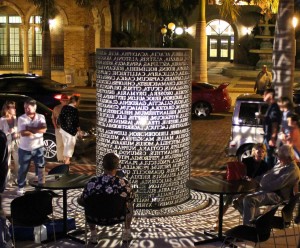 Sanborn’s most famous work remains Kryptos, a $250,000 commission he installed outside the main entrance to the CIA’s headquarters in Langley, Virginia. The sculpture’s name means hidden in Greek and Sanborn duly embedded four puzzles in the curved copper panels that make up the sculpture. He and a retired CIA cryptographer spend four months devising the codes, and within the first few years, a CIA physicist deciphered three of them using nothing more than a pen and paper. (The first encryption was a poetic phrase that Sanborn composed; the second refers to the CIA agent who helped Sanborn with the four puzzles; and the third is a passage from archeologist Howard Carter’s account of opening of Pharaoh Tutankhamun’s tomb in the Valley of the Kings in 1922.) But the fourth riddle has defied solution.
Sanborn’s most famous work remains Kryptos, a $250,000 commission he installed outside the main entrance to the CIA’s headquarters in Langley, Virginia. The sculpture’s name means hidden in Greek and Sanborn duly embedded four puzzles in the curved copper panels that make up the sculpture. He and a retired CIA cryptographer spend four months devising the codes, and within the first few years, a CIA physicist deciphered three of them using nothing more than a pen and paper. (The first encryption was a poetic phrase that Sanborn composed; the second refers to the CIA agent who helped Sanborn with the four puzzles; and the third is a passage from archeologist Howard Carter’s account of opening of Pharaoh Tutankhamun’s tomb in the Valley of the Kings in 1922.) But the fourth riddle has defied solution.
In November of 2010, Sanborn became so flummoxed by the CIA’s inability to crack the last code that he decided to give everyone a clue. Sanborn told the New York Times that the part of the sculpture that reads “nypvtt” becomes Berlin once decoded. Sounds promising enough until you discover that only 97 of the 869 characters carved into the main portion of the sculpture apply to the encryption and so far, only two of those 97 characters have been identified and correctly deciphered.
Fortunately, Sanborn did not encode any part of Caloosahatchee Manuscripts. At least as far as anyone knows.
[If you’d like to know more about Caloosahatchee Manuscripts or Jim Sanborn, please visit http://www.artswfl.com/galleries/fort-myers-river-district/public-art-installations/caloosahatchee-manuscripts/caloosahatchee-manuscripts.]
 Last Stop: the Sidney & Berne Davis Art Center. Although the art center is not technically a public “artwork,” it is one of the most cognizable edifices in the entire River District. Some describe the building as the Fort Myers Parthenon. With slender limestone and coral columns, scrolled capitals and stacked bases, the Temple of Athena Nike on the Acropolis in Athens is a more apt simile. Either way, the building is one of the nation’s finest examples of neoclassical revival architecture.
Last Stop: the Sidney & Berne Davis Art Center. Although the art center is not technically a public “artwork,” it is one of the most cognizable edifices in the entire River District. Some describe the building as the Fort Myers Parthenon. With slender limestone and coral columns, scrolled capitals and stacked bases, the Temple of Athena Nike on the Acropolis in Athens is a more apt simile. Either way, the building is one of the nation’s finest examples of neoclassical revival architecture.
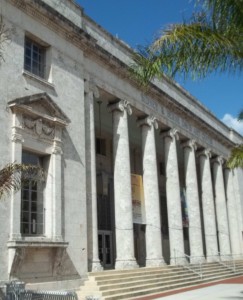 The 78-year-old building that is home to the Sidney & Berne Davis Art Center has quite an interesting history, and SBDAC does have plans to register the building in due course as an historical landmark. The building sits on the site of a former settlement of Calusa Indians. In the mid-1800s, the federal government built a fort on the banks of the Caloosahatchee River, and the officers’ quarters were located where the SBDAC now stands. During the Depression, the Works Project Administration decided to use the location for a new federal post office, and the WPA commissioned prominent Florida architect Nat Gaillard Walker to design the facility.
The 78-year-old building that is home to the Sidney & Berne Davis Art Center has quite an interesting history, and SBDAC does have plans to register the building in due course as an historical landmark. The building sits on the site of a former settlement of Calusa Indians. In the mid-1800s, the federal government built a fort on the banks of the Caloosahatchee River, and the officers’ quarters were located where the SBDAC now stands. During the Depression, the Works Project Administration decided to use the location for a new federal post office, and the WPA commissioned prominent Florida architect Nat Gaillard Walker to design the facility.
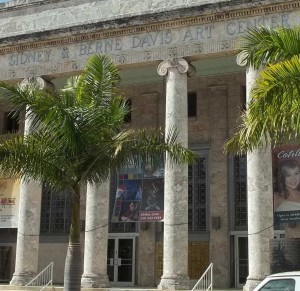 Walker was a fan of neoclassical architecture. He especially admired19th Century British architect Sir John Sloan and Thomas Jefferson, who took time away from his duties as our third president to design not only his neoclassical residence at Monticello but the trademark columns and south portico of the White House. But by the 1920s, the elegant, if not flamboyant, architecture of Sloan and Jefferson had been replaced by the spare, functional style of Frank Lloyd Wright and the German Bauhaus. Both roundly rejected the use of embellishments like columns, false mouldings, scrolls and pilasters. But when their new post office was completed in 1933, Fort Myers residents were delighted to find that were recipients of the first neoclassical revival structure in the country. Civic pride was buoyed again four years later when the most famous example of neoclassical revival architecture, the Jefferson Memorial, was completed under the stewardship of John Russell Pope.
Walker was a fan of neoclassical architecture. He especially admired19th Century British architect Sir John Sloan and Thomas Jefferson, who took time away from his duties as our third president to design not only his neoclassical residence at Monticello but the trademark columns and south portico of the White House. But by the 1920s, the elegant, if not flamboyant, architecture of Sloan and Jefferson had been replaced by the spare, functional style of Frank Lloyd Wright and the German Bauhaus. Both roundly rejected the use of embellishments like columns, false mouldings, scrolls and pilasters. But when their new post office was completed in 1933, Fort Myers residents were delighted to find that were recipients of the first neoclassical revival structure in the country. Civic pride was buoyed again four years later when the most famous example of neoclassical revival architecture, the Jefferson Memorial, was completed under the stewardship of John Russell Pope.
The federal government built a new post office at another location in 1965 and converted the building into a federal courthouse. In the process, they regrettably removed or covered over many of the unique architectural features that Nat Gaillard Walker had included in the interior. And when the federal judiciary also moved to another location in 1998, the people in charge of the building turned off the power and locked the doors. Water found its way inside and dripped down the walls. Woodwork split. Plaster fell. Drop ceilings sagged. Mold grew unchecked in the non-ventilated interior. And Nat Gaillard Walker’s stately building fell into seemingly hopeless disrepair.
But two years later, the City of Fort Myers purchased the building from the federal government and leased it for 99 years to Florida Arts, Inc. with a mandate that Florida Arts restore the building and convert it into a cultural arts center. “When the federal courthouse building became available,” recollects SBDAC Chairman and CEO Jim Griffith, “it just said ‘art center’ all over it. I paid the rent for the entire 99-year term in advance.”
[If you would like to know more about the Sidney & Berne Davis Art Center, please visit http://www.artswfl.com/galleries/fort-myers-river-district/public-art-installations/sidney-berne-davis-art-center/sidney-berne-davis-art-center.]
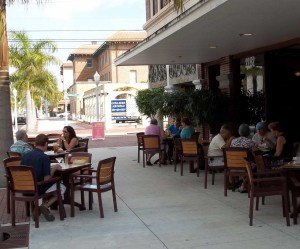 Returning to the Start. While you are in the River District, there’s a lot of other places to see and activities to do. You can and certainly should visit the River District’s eight art galleries, which include in alphabetical order Art League of Fort Myers Gallery, Art of the Olympians, Arts for ACT Gallery, Coloring the World, daas Gallery, HOWL Gallery/Tattoo, In One Instant Gallery of Photography, Sidney & Berne Davis Art Center and Space 39. Nearby antique shops include Main Street Antiques & Collectibles and Ivy Cottage, with Enjewel, Franklin Shops, Savvy on First and Arts for ACT adding chic, stylish boutique shopping to the downtown landscape. If you are hungry or thirsty, you can dine or simply enjoy a drink at Morgan House, The French Connection, Twisted Vine Bistro (formerly H2), the Veranda, Ichiban Chinese & Japanese Cuisine, United Cafe’, Bar & Bistro, Downtown House of Pizza, What’s Up Dogs, Starbucks Coffee, Hideway Sports Bar, Red Rock Saloon, Spirits of Bacchus and The World Famous Cigar Bar.
Returning to the Start. While you are in the River District, there’s a lot of other places to see and activities to do. You can and certainly should visit the River District’s eight art galleries, which include in alphabetical order Art League of Fort Myers Gallery, Art of the Olympians, Arts for ACT Gallery, Coloring the World, daas Gallery, HOWL Gallery/Tattoo, In One Instant Gallery of Photography, Sidney & Berne Davis Art Center and Space 39. Nearby antique shops include Main Street Antiques & Collectibles and Ivy Cottage, with Enjewel, Franklin Shops, Savvy on First and Arts for ACT adding chic, stylish boutique shopping to the downtown landscape. If you are hungry or thirsty, you can dine or simply enjoy a drink at Morgan House, The French Connection, Twisted Vine Bistro (formerly H2), the Veranda, Ichiban Chinese & Japanese Cuisine, United Cafe’, Bar & Bistro, Downtown House of Pizza, What’s Up Dogs, Starbucks Coffee, Hideway Sports Bar, Red Rock Saloon, Spirits of Bacchus and The World Famous Cigar Bar.
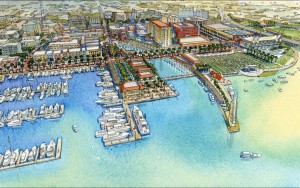 When you are ready to go home, take Bay Street back to where you parked your car. This will not only treat you to an incredible view of Fire Dance, it will enable you to ponder the next phase in the evolution of the River District and its development into a worldwide cultural center. Thanks to a $200 million riverfront redevelopment plan adopted in 2010, downtown Fort Myers will soon have a 1.8-acre water basin that will bring an inlet from the Caloosahatchee River to the corner of Hendry and Bay Streets. Also planned are a 12-story, 220-room convention-quality hotel overlooking the basin, an 82,000 square-foot addition that will more than double the size of the Harborside Event Center, and more outstanding restaurants, shops and art galleries on Hendry Street along the basin, plus a parking garage to accommodate these new facilities. The city plan includes plenty of public plazas, open areas and expanded marina facilities designed to transform the River District into an international tourist and convention destination.
When you are ready to go home, take Bay Street back to where you parked your car. This will not only treat you to an incredible view of Fire Dance, it will enable you to ponder the next phase in the evolution of the River District and its development into a worldwide cultural center. Thanks to a $200 million riverfront redevelopment plan adopted in 2010, downtown Fort Myers will soon have a 1.8-acre water basin that will bring an inlet from the Caloosahatchee River to the corner of Hendry and Bay Streets. Also planned are a 12-story, 220-room convention-quality hotel overlooking the basin, an 82,000 square-foot addition that will more than double the size of the Harborside Event Center, and more outstanding restaurants, shops and art galleries on Hendry Street along the basin, plus a parking garage to accommodate these new facilities. The city plan includes plenty of public plazas, open areas and expanded marina facilities designed to transform the River District into an international tourist and convention destination.
These farsighted and ambitious plans also present the city of Fort Myers with a unique opportunity to build a worldwide reputation as a cultural center in which the visual and performing arts thrive and new generations of artists like Bob Rauschenberg, Darryl Pottorf and Marcus Jansen, as well as actors, actresses, musicians and filmmakers all become imbued with boundless creativity and a passion for personal excellence. The next twenty years promise to be even more exciting than the last two decades, and public art can be expected to play a huge role in the River District’s transformation into both a convention and cultural center that enjoys global prominence.
That completes the walking tour of the public artworks located within the strict confines of the downtown Fort Myers River District. However, the 14 stops you’ve just made represent only a portion of the City of Fort Myers’ public art collection. Click here for information about the rest.
Thank you for both your time and your interest.













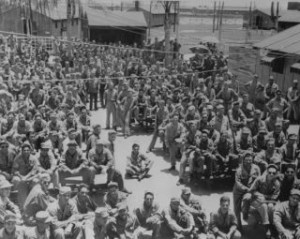

 Tom Hall is both an amateur artist and aspiring novelist who writes art quest thrillers. He is in the final stages of completing his debut novel titled "Art Detective," a story that fictionalizes the discovery of the fabled billion-dollar Impressionist collection of Parisian art dealer Josse Bernheim-Jeune, thought by many to have perished during World War II when the collection's hiding place, Castle de Rastignac in southern France, was destroyed by the Wehrmacht in reprisal for attacks made by members of the Resistance operating in the area. A former tax attorney, Tom holds a bachelor's degree as well as both a juris doctorate and masters of laws in taxation from the University of Florida. Tom lives in Estero, Florida with his fiancee, Connie, and their four cats.
Tom Hall is both an amateur artist and aspiring novelist who writes art quest thrillers. He is in the final stages of completing his debut novel titled "Art Detective," a story that fictionalizes the discovery of the fabled billion-dollar Impressionist collection of Parisian art dealer Josse Bernheim-Jeune, thought by many to have perished during World War II when the collection's hiding place, Castle de Rastignac in southern France, was destroyed by the Wehrmacht in reprisal for attacks made by members of the Resistance operating in the area. A former tax attorney, Tom holds a bachelor's degree as well as both a juris doctorate and masters of laws in taxation from the University of Florida. Tom lives in Estero, Florida with his fiancee, Connie, and their four cats.